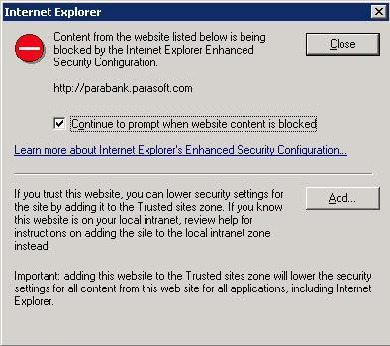General Settings
We recommend configuring the following settings for optimal recording and playback performance on Internet Explorer. Choose settings (gear icon)> Internet options from the IE menu tp access the configuration options.
Advanced Options
- Click the Advanced tab and locate the Browsing settings.
- Enable the Enable third-party browser extensions option. This setting is required.
- Locate the Security options and enable the Enable Enhanced Protected Mode option. This setting is required for IE 10 and later. Restart is required for this setting to take effect.
- Click OK.
Security Options
- Click the Security tab and choose a zone (Internet, Local intranet, Trusted sites, Restricted sites).
- Disable the Enable Protected Mode option. This setting should always be disabled.
- Disable the option for all other zones and click OK
The following settings apply to all zones except for Restricted sites:
- Choose any zone (except for Restricted sites) and click Custom level . . .
- Locate the Scripting section and enable the Active scripting option. This setting should always be enabled.
- Enable this option for the other zones except for Restricted sites and click OK.
The following settings apply to the Local intranet zone and may not be required in all cases:
- Choose Local intranet and click Sites.
- Disable the Automatically detect intranet network option.
- Enable the following options and click OK:
- Include all local (intranet) sites not listed in other zones
- Include all sites that bypass the proxy server
- Include all network paths (UNCs)
Troubleshooting the "Unable to start Internet Explorer framework" Error
If you’re using the above recommended configurations but are still receiving "Unable to start Internet Explorer framework" errors, try the following troubleshooting steps:
- Make sure there is enough time for the browser and first page to completely load. To do this, check that Parasoft> Preferences> Parasoft> Browser> Browser Timeout Settings> Startup Timeout is set to a large enough time period. This is particularly relevant on slow computers and with sites that take a long time to initially load.
If the page did not load, ensure that the SOAtest and/or Virtualize proxy settings are configured correctly and verify that there are no lingering instances of Internet Explorer running. Instances of Internet Explorer left over from previous browser testing sessions can interact with new instances, potentially causing conflict.
Security Settings
Internet Explorer’s Enhanced Security Configuration and Protected Mode cannot be enabled while you are working with SOAtest and/or Virtualize.
Enhanced Protection Mode
Enhanced Protected Mode (added in Internet Explorer 10) is not supported when recording and playing back scenarios.
If Enhanced Protected Mode is enabled, you will see a warning dialog indicating that "'Recorder Registrar Class' from 'Unknown Publisher' isn't compatible with Internet Explorer's enhanced security features and has been disabled" when you attempt to record or play back a scenario in Virtualize. If you do not disable Enhanced Protected Mode, certain Virtualize functionality disabled—including recording traffic, and automatically logging in using NTLM/digest/basic authentication.
To disable Enhanced Protected Mode in Internet Explorer, go to Tools> Internet Options> Advanced>, then clear Security> Enable Enhanced Protected Mode.
Enhanced Security Configuration
On Windows Servers 2003 and 2008, Internet Explorer Enhanced Security Configuration is enabled by default. The Enhanced Security Configuration will prevent SOAtest and/or Virtualize from playing back browser scenarios in Internet Explorer on those machines. When Internet Explorer starts, a dialog similar to the following will appear and the scenarios will not complete:
To run browser playback and recording on these machines, you should disable the Enhanced Security Configuration as described in http://www.visualwin.com/IE-enhanced-security/. For more information about the Enhanced Security Configuration, see Using Internet Explorer Enhanced Security Configuration on Terminal Servers (MSDN Website).
Alternatively, you can prevent this dialog from displaying by configuring the Enhanced Security Configuration so that sites are "trusted" as described in http://support.microsoft.com/kb/933991. This will allow SOAtest and/or Virtualize to play back the scenarios. However, the recommended approach is to completely disable the Enhanced Security Configuration.
Protected Mode
If Internet Explorer is running in Protected Mode, Protected Mode will automatically be disabled for all four zones: internet, local intranet, restricted, and trusted.
To re-enable Protected Mode:
- Open Internet Explorer's Internet Options dialog.
- Open the Security tab.
- Select a Web content zone.
- Check the Enable Protected Mode check box.
To verify that Protected Mode has been successfully re-enabled, look for the words "Protected Mode: On" next to the Web content zone displayed in Internet Explorer's status bar.


